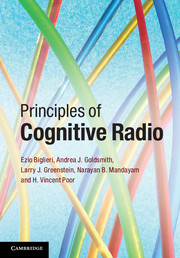5 - Spectrum exploration and exploitation
Published online by Cambridge University Press: 05 December 2012
Summary
Introduction
Chapter motivation
Chapter 4 introduced the basic spectrum sensing framework for detecting the presence of primary users in a cognitive radio system. In this chapter, we develop this framework further by taking a look at how a cognitive radio system or a cognitive radio network can optimize its spectrum sensing and access functions in order to explore and exploit the spectrum in the most efficient and effective manner. Chapters 1 and 2 described three cognitive radio network paradigms, i.e., the underlay, overlay, and interweave paradigms. In this chapter, we focus almost exclusively on the interweave paradigm in which the secondary users try to exploit the spatio-temporal spectral opportunities (i.e., spectrum holes) resulting from intermittent and uneven spatial and temporal use of the spectrum by the primary users. As described in Chapter 4, these spectrum holes are typically considered to be white spaces, i.e., completely empty of any signals, except for noise. In addition, we will consider a few approaches suitable also for the underlay paradigm. In particular, we will consider game-theoretic techniques and algorithms for spectrum access and sharing in cognitive radio networks that operate under interference temperature constraints, as described in Chapter 4. The remaining third paradigm, the overlay paradigm, is not explicitly considered in this chapter.
- Type
- Chapter
- Information
- Principles of Cognitive Radio , pp. 184 - 258Publisher: Cambridge University PressPrint publication year: 2012
- 1
- Cited by

